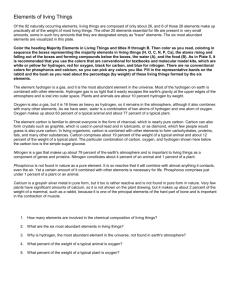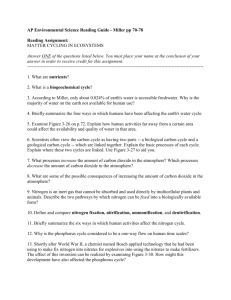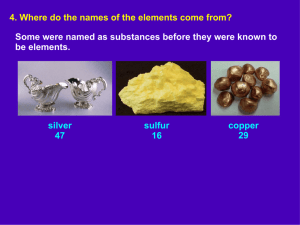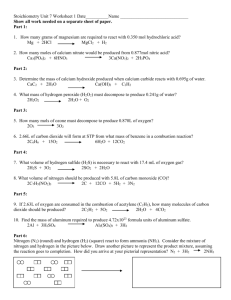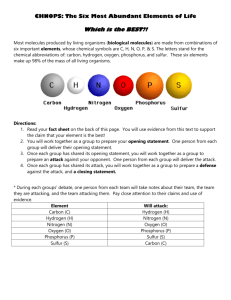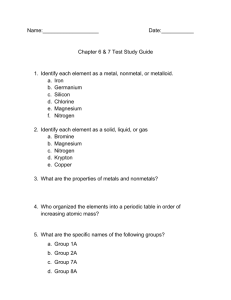THE ELEMENTS OF LIFE
advertisement
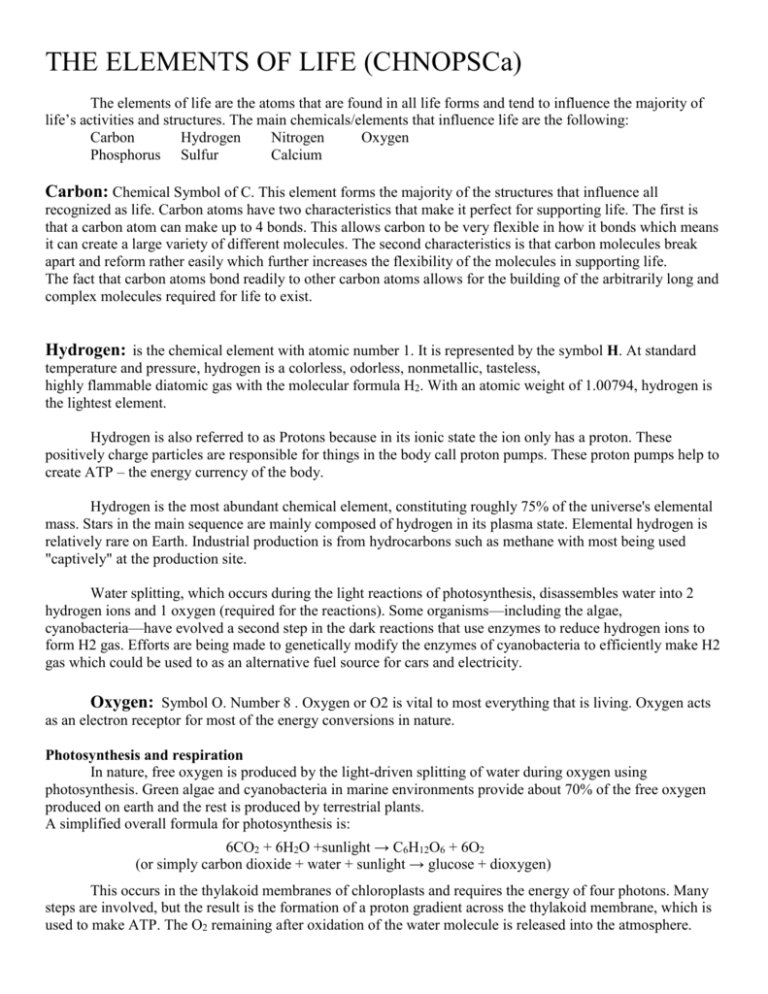
THE ELEMENTS OF LIFE (CHNOPSCa) The elements of life are the atoms that are found in all life forms and tend to influence the majority of life’s activities and structures. The main chemicals/elements that influence life are the following: Carbon Hydrogen Nitrogen Oxygen Phosphorus Sulfur Calcium Carbon: Chemical Symbol of C. This element forms the majority of the structures that influence all recognized as life. Carbon atoms have two characteristics that make it perfect for supporting life. The first is that a carbon atom can make up to 4 bonds. This allows carbon to be very flexible in how it bonds which means it can create a large variety of different molecules. The second characteristics is that carbon molecules break apart and reform rather easily which further increases the flexibility of the molecules in supporting life. The fact that carbon atoms bond readily to other carbon atoms allows for the building of the arbitrarily long and complex molecules required for life to exist. Hydrogen: is the chemical element with atomic number 1. It is represented by the symbol H. At standard temperature and pressure, hydrogen is a colorless, odorless, nonmetallic, tasteless, highly flammable diatomic gas with the molecular formula H2. With an atomic weight of 1.00794, hydrogen is the lightest element. Hydrogen is also referred to as Protons because in its ionic state the ion only has a proton. These positively charge particles are responsible for things in the body call proton pumps. These proton pumps help to create ATP – the energy currency of the body. Hydrogen is the most abundant chemical element, constituting roughly 75% of the universe's elemental mass. Stars in the main sequence are mainly composed of hydrogen in its plasma state. Elemental hydrogen is relatively rare on Earth. Industrial production is from hydrocarbons such as methane with most being used "captively" at the production site. Water splitting, which occurs during the light reactions of photosynthesis, disassembles water into 2 hydrogen ions and 1 oxygen (required for the reactions). Some organisms—including the algae, cyanobacteria—have evolved a second step in the dark reactions that use enzymes to reduce hydrogen ions to form H2 gas. Efforts are being made to genetically modify the enzymes of cyanobacteria to efficiently make H2 gas which could be used to as an alternative fuel source for cars and electricity. Oxygen: Symbol O. Number 8 . Oxygen or O2 is vital to most everything that is living. Oxygen acts as an electron receptor for most of the energy conversions in nature. Photosynthesis and respiration In nature, free oxygen is produced by the light-driven splitting of water during oxygen using photosynthesis. Green algae and cyanobacteria in marine environments provide about 70% of the free oxygen produced on earth and the rest is produced by terrestrial plants. A simplified overall formula for photosynthesis is: 6CO2 + 6H2O +sunlight → C6H12O6 + 6O2 (or simply carbon dioxide + water + sunlight → glucose + dioxygen) This occurs in the thylakoid membranes of chloroplasts and requires the energy of four photons. Many steps are involved, but the result is the formation of a proton gradient across the thylakoid membrane, which is used to make ATP. The O2 remaining after oxidation of the water molecule is released into the atmosphere. Molecular dioxygen, O2, is essential for cellular respiration in all aerobic organisms. Oxygen is used in mitochondria to help make adenosine triphosphate (ATP) during oxidative phosphorylation (sticking on phosphate groups). The reaction for aerobic respiration is essentially the reverse of photosynthesis and is simplified as: C6H12O6 + 6O2 → 6CO2 + 6H2O + Energy In vertebrates, O2 is diffused through membranes in the lungs and into red blood cells. Hemoglobin binds O2, changing its color from bluish red to bright red. Other animals use other compounds. A liter of blood can dissolve 200ml of O2. Some types of oxygen are reactive, such as superoxide ion (O2−) and hydrogen peroxide (H2O2), are dangerous by-products of oxygen used in organisms. Some organisms created these dangerous versions as a way to kill off bacteria and other disease causing agents. An adult human in rest inhales 1.8 to 2.4 grams of oxygen per minute. This amounts to more than 6 billion tons of oxygen inhaled by humanity per year. NITROGEN: Nitrogen’s role in most living things ranges from waste products to organ building (proteins). Nitrogen is an essential part of amino acids and nucleic acids, both of which are essential to all life on Earth. Molecular nitrogen in the atmosphere cannot be used directly by either plants or animals, and needs to be converted into nitrogen compounds, or "fixed," in order to be used by life. Rain often contains substantial quantities of ammonium and nitrate, both thought to be a result of nitrogen fixation by lightning. However, because ammonium is captured by the forest canopy, most of the fixed nitrogen that reaches the soil surface under trees is in the form of nitrate which is absorbed by plant roots. Specific bacteria enzymes fix atmospheric nitrogen into a form that is useful for other organisms. Some plants are able to absorb nitrate which may be present in soil from natural mineral deposits, artificial fertilizers, animal waste, or organic decay (as the product of bacteria, but not bacteria specifically associated with the plant). Nitrates absorbed in this fashion are converted to nitrites and then to ammonium by enzymes. Nitrogen compounds are basic building blocks in animal biology because it is used to make compounds called amino acids. Amino acids are used to make protein, and so a steady supply of nitrogen is needed, so that an organism can produce the proteins it requires. Decay of organisms and their waste products may produce small amounts of nitrate, but most decay eventually returns nitrogen content to the atmosphere, as molecular nitrogen. PHOSPHORUS: Phosphorus is a key element in all known forms of life. Inorganic phosphorus in the form of the phosphate PO43- plays a major role in biological molecules such as DNA and RNA where it forms part of the structural framework of these molecules. Living cells also use phosphate to transport energy via adenosine triphosphate (ATP). Nearly every cellular process that uses energy obtains it in the form of ATP. ATP is also important for phosphorylation (sticking on phosphate groups – like a battery). Phospholipids, phosphate rich lipid molecules, are the main structural and functional components of all cellular membranes. An average adult human contains a little less than 1 kg of phosphorus, about 85% of which is present in bones and teeth in the form of apatite (hard white stuff that surrounds the proteins), and the remainder inside cells in soft tissues. A well-fed adult in the USA consumes and excretes about 1-3 g of phosphorus per day in the form of phosphate. Only about 0.1% of body phosphate circulates in the blood, but this amount reflects the amount of phosphate available to soft tissue cells. Phosphorus is an essential macromineral for plants, In ecological terms, phosphorus is often a limiting factor in many environments; i.e. the availability of phosphorus governs the rate of growth of many organisms. Too much phosphorus can be problematic, especially in aquatic systems, causing things like algal blooms. SULFUR: Sulfur is an essential component of all living cells. It is the chemical element that has the atomic number 16. It is denoted with the symbol S. It is an abundant, multivalent non-metal. Sulfur in its native form is a yellow crystalline solid. In nature, it can be found as the pure element and as sulfide and sulfate minerals. It is an essential element for life and is found in two amino acids, cysteine and methionine. Its commercial uses are primarily in fertilizers, but it is also widely used in black gun powder, matches, insecticides and fungicides. Elemental sulfur crystals are commonly sought after by mineral collectors for their brightly colored polyhedron shapes. In nonscientific context it can also be referred to as brimstone. Sulfur may also serve as chemical food source for some primitive organisms: some forms of bacteria use hydrogen sulfide (H2S) in the place of water as the electron donor in a primitive photosynthesis-like process in which oxygen is the electron receptor. Primitive bacteria which live around deep ocean volcanic vents oxidize hydrogen sulfide with oxygen. The so-called sulfur bacteria, by contrast, "breathe sulfate" instead of oxygen. They use sulfur as the electron acceptor, and reduce various oxidized sulfur compounds back into sulfide-- often into hydrogen sulfide. They also can grow on a number of other partially oxidized sulfur compounds. These bacteria are responsible for the rotten egg smell of some intestinal gases and decomposition products. Disulfide bonds (S-S bonds) formed between two cysteines in a peptide chain are very important in protein assembly and structure. These strong covalent bonds between peptide chains give proteins a great deal of extra toughness and resiliency. For example, the high strength of feathers and hair is in part due to their high content of S-S bonds and their high content of cysteine and sulfur (eggs are high in sulfur because large amounts of the element are necessary for feather formation). The high disulfide content of hair and feathers contributes to their indigestibility, and also their odor when burned. CALCIUM: is the chemical element with the symbol Ca and atomic number 20. It has an atomic mass of 40.078 amu. Calcium is a soft grey alkaline earth metal, and is the fifth most abundant element by mass in the Earth's crust. Calcium is also the fifth most abundant dissolved ion in seawater by both molarity and mass, after sodium, chloride, magnesium, and sulfate. Calcium is essential for living organisms, particularly in cell physiology, where movement of the calcium ion Ca2+ into and out of the cytoplasm functions as a signal for many cellular processes. As a major material used in mineralization of bones and shells, calcium is the most abundant metal by mass in many animals. Calcium is the fifth most abundant element by mass in the human body, where it is a common cellular ionic messenger with many functions, and serves also as a structural element in bone. Of the human body's solid components after drying (as for example, after cremation), about a third of the total mass is the approximately one kilogram of calcium which composes the average skeleton (the remainder being mostly phosphorus and oxygen). Calcium, combined with phosphate to form hydroxylapatite, is the mineral portion of human and animal bones and teeth. The mineral portion of some corals can also be transformed into hydroxylapatite. Calcium is involved with many of the processes of life. Most importantly: Cell division, Muscle Contraction, cell messenger, neurotransmitter, and heart beat regulation.



